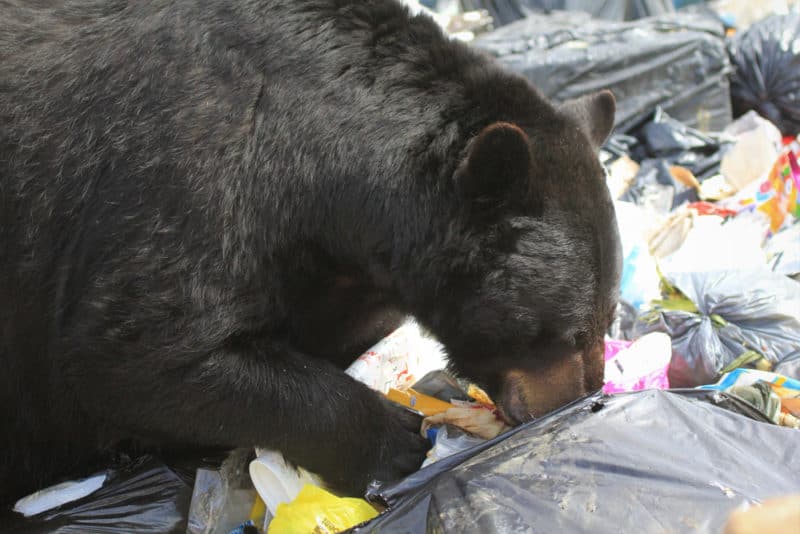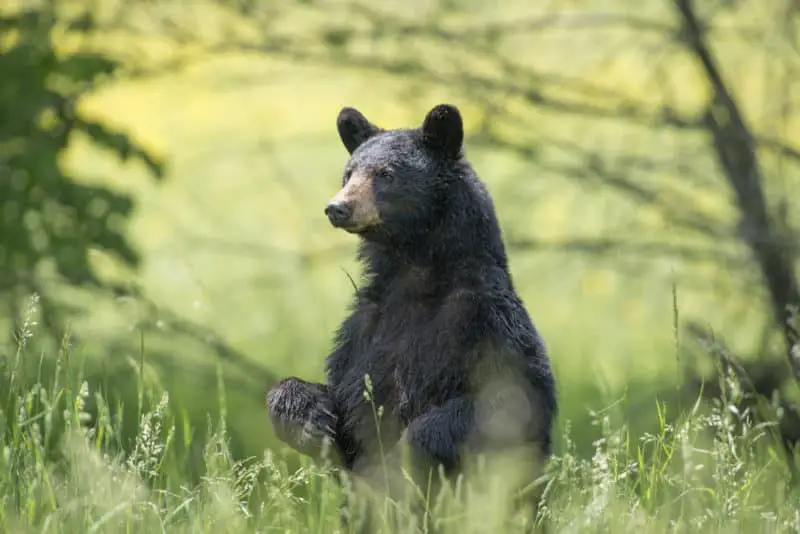Missouri is home to the American black bear. At one time, game officials believed that bears were extinct from the state. That isn’t the case anymore, though. According to a study done by the Missouri Department of Conservation, the state black bear population is 540-840 bears. Additionally, their population has a growth rate of 9% annually.
In 2021 the Missouri Department of Conservation conducted its inaugural bear hunt.
History of black bears in Missouri
There are three different bear species that inhabit North America. They are the polar bear, the brown/grizzly bear, and the American black bear. Of those three, the only one that has ever lived in Missouri is the black bear.
Historically, black bears thrived throughout the forested areas in what is now the state of Missouri, particularly in the Ozark mountains. When Lewis and Clark’s Corps of Discovery passed through the area in 1804, they reported harvesting 11 of the bruins.
Missouri became the 24th U.S. state on August 10, 1821. As European/ American settlers flooded into the new state, game animals such as elk, white-tailed deer, and black bears began to disappear. There was no agency to regulate hunting, and people hunted not only for subsistence living but also to sell meat, hides, and in the case of bears, oil. Overhunting and loss of habitat because of logging took a heavy toll on Missouri’s game populations. Eastern elk disappeared from Missouri by 1865. Furthermore, the majority of Missouri’s bear population disappeared by the early 1900s.
The last of the state’s black bears hung on in the boot-heel in the southeastern portion of the state. However, it was thought that those bears all died in the great Mississippi River flood of 1927.
Transient black bears from Arkansas
The history of black bears in the Ozarks of Arkansas is similar to that in Missouri. However, between 1958 and 1968, the Arkansas Game and Fish Commission relocated 254 bears from Minnesota and Canada into the Arkansas Ozark Mountains.
Today there are over 5000 black bears in Arkansas, and part of that population has migrated north into Missouri. This is the source of a lot of Missouri’s bear population. However, DNA evidence suggests that Missouri’s Black bears were never really extinct after all. There were always some remnant bears in the state’s Ozark Mountains that have combined with the transient bears from Arkansas to form the basis of the Black bear population that the state has today.
Furbearer and black bear biologist Laura Conlee who is a lead on the Missouri bear project, says it’s important for people to remember that Missouri is bear country. She encourages people to become bear-aware. This means knowing how to not attract bears to your home if you happen to live in bear country. It also means knowing what to do if you run into a bear on a trail. Source
According to MDC biologists, early summer is prime time to see young male black bears on the move. As bear numbers increase, young bears will strike out in search of potential food sources and new areas to occupy, sometimes covering large distances.

How to make your home less attractive to bears
Besides being dangerous apex predators, bears can potentially cause significant damage to your home and or vehicles. For example, if a black bear smells food in your parked car, it is capable of tearing the door off to get to it.
The following tips will make your property less attractive to wandering bears.
Pet food
It’s a bad idea to feed your outside pets more than they can efficiently clean up before dark. It’s also a bad idea to store your pet food outside. If you store your pet food outside, keep it in a bear-proof container.
Barbeque grills
Backyard barbecue grills are bear attractors. You Should clean your barbecue grill after every use and store it inside. If you live on a large property, dispose of your grease drippings and food waste in an area far away from your home. For the majority of people, though, who don’t live on a large acreage, the best thing to do is to store your grease drippings and food waste in the refrigerator until the day of your garbage pickup and then throw it away just before the garbage truck comes. Along this line, you should also store indoors and clean and disinfect your garbage cans regularly.
Vehicles
Keep all food or empty containers that have had food in them out of your vehicles. Bears have a keen sense of smell. Furthermore, as I mentioned earlier, an adult black bear is capable of bending your car door in half if it decides it wants to get inside.
Use electric fencing
If you have a vegetable garden, a chicken coop, an orchard, or any other outside bear attractants, you should conder using electric fencing to keep the bears at bay.
Bird feeders will attract bears.
Also, bird feeders have the potential to bring bears to your property, whether that be hummingbird feeders or ones that dispense out bird seed.
Never feed the bears.
A huge mistake that people sometimes make is to put food out to attract bears on purpose. When you do that, you create a situation that is beyond your control.
When bears begin to associate people with food, they lose any fear of humans that they might have had. They also might act out aggressively if they decide that you’re not giving them the food that they want and are accustomed to. Bears that are habituated to getting food from humans will have to be destroyed. to quote MDC Wildlife Management Coordinator Alan Leary, “Remember, a fed bear is a dead bear. “
How dangerous are black bears?
Black bears are generally a non-aggressive species of bear. They are omnivores, and in some cases, 96% of their diet is plant material. Additionally, when you surprise a black bear, they are much more likely to run away than to come towards you. However, between 2001 and 2021, black bears killed 28 people in North America. As you can see, black bears are not non-aggressive all the time.
Bear attacks fall into 2 categories. The first is defensive, and the second is predatory. 90% of black bear attacks on humans are predatory. Additionally, they’re almost always perpetrated by young adult males in the late summer or fall.
At this time of year, bears are going through a hyperphagic stage where they are packing on fat prior to going into their winter dens. Bears that were eating around 8,000 calories per day start taking in up 20,000 calories per day when they enter hyperphagia. It’s extremely rare, but sometimes these hyperphagic bears see humans as a potential food source.
88% of the fatal attacks carried out by black bears on humans between 1960 and 2009 were predatory and not defensive in nature and were carried out by lone male bears. This means that in the case of black bears, a mother bear with cubs is less dangerous than a predatory male bear. Source See here on how to recognize a predatory bear and what to do if you encounter one.
Bear hunting in Missouri
Permits for Missouri’s first-ever black bear hunt in 2021 were only available to Missouri residents. There were 400 tags available that were awarded through a random drawing. The harvest quota was 40 bears. The hunt took place in 3 designated bear management zones south of the Missouri River. Each permit was issued for a specific BMZ, and hunting was limited to public or private property within that BMZ.
The harvest quotas for the number of bears allowed to be harvested in the inaugural 2021 bear hunting season were as follows. Zone 1- 20 bears, Zone 2- 15 bears, Zone 3- 5 bears.
BMZ #1 contains McDonald, Barry, Stone, Taney, Ozark, Douglas, and Christian counties. It also contains parts of Jasper, Lawrence, Greene, Webster, Wright, Texas, and Howell counties.
BMZ#2 contains Dunkin, New Madrid, Pemiscot, Mississippi, Stoddard, Scott, Bollinger, Cape Girardeau, Ste. Genevieve, St. Francis, Jefferson, St. Luis, Washington, Iron, Reynolds, Madison, Wayne, Butler, Ripley, Oregon, Shannon, Dent, and Crawford counties. It also contains parts of Howell, Texas, Phelps, Crawford, and Franklin counties.
BMZ#3 contains Jackson, Cass, Bates Vernon, Barton, Jasper, Lafayette, Johnson, Henry, Saint Clair, Cedar, Dade, Saline, Pettis, Benton, Hickory, Polk, Cooper, Moniteau, Morgan, Camden, Miller, Dallas, Webster, Laclede, Pulaski, Maries, Osage, and Gasconade counties. It also contains parts of Franklin, Phelps, Texas, Wright, Webster, Greene Lawrence, and Jasper counties.
In total, for 2021, 12 bears were harvested in Missouri. Of these 12 bears, 9 of them came from zone number 1, while 3 of them came from zone number 2.
The 2022 Missouri bear hunt will take place Oct. 17-26. The information on the 2022 hunt, such as the number of permits awarded, the harvest quota, etc., is identical to 2021.
Recent Posts
The only venomous snakes in Washington State are Northern Pacific Rattlesnakes. The Northern Pacific Rattlesnake (Crotalus oreganus oreganus) is a sub-species of the Western Rattlesnake. Anyone...
Skunks are not classified as true hibernators. But they go into a state of torpor when the weather gets cold. Skunks are light sleep hibernators, along with opossums, bears, and raccoons. ...

